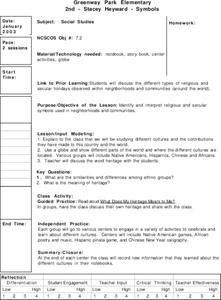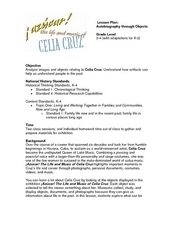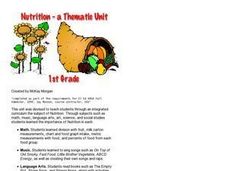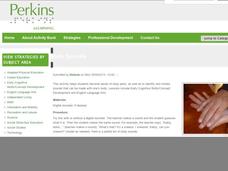Curated OER
Babar's Travels
Students read the story The Story of Babar and have a class discussion about his travels, discuss their families, design a map, pick music, and more. In this cross curricular musical lesson plan, students create a music map for each of...
Curated OER
Traditions and Transformations
Ninth graders examine the Jewish culture from a variety of perspectives. In this ethics activity, 9th graders interview guest speakers on the subject of Jewish culture. Students create group poems and murals around themes of...
Curated OER
Sharing Beauty Through Song
Students perform a song for their school community. In this music instructional activity, students sing the philanthropic song See Me Beautiful by Red Grammar and reflect upon the lyrics. Students perform the song for their school...
Curated OER
200 Greatest Pop Culture Icons
Learners define the term "exoticism" and identify musical elements used by 19th and 20th century composers and modern pop icons to convey exoticism.
Curated OER
National Anthems of the World
Young scholars compare and contrast music and lyrics of national anthems from around the world. They listen to their national anthem and other countries' anthems and compare the music. Working in groups, they write an anthem for their...
Curated OER
GET READY FOR FCAT WITH MUSIC IN OUR SCHOOLS MONTH!
Students integrate writing skills with music. They select three to four topics to write about and print out on decorative paper.
Curated OER
Holidays Around The World
Second graders investigate the different holidays that are celebrated in cultures around the world. They identify the different symbols used in celebration and differentiate the interpretation. Students demonstrate in writing how the...
Curated OER
Can You See the Music?
Fourth graders examine the makeup of the electromagnetic spectrum and how the various forms of EMRs are similar and different from each other. They, in pairs, solve problems from worksheets imbedded in this lesson plan.
Perkins School for the Blind
What Do I Hear?
Being able to give positive reinforcers to a child starts with knowing what the child likes. Intended for children with blindness, this instructional activity gives you a way to determine the types of music your learners like best....
Smithsonian Institution
Autobiography through Objects
Show youngsters how objects can tell a story! Here your class will learn about Cuban salsa dancer Celia Cruz by analyzing pictures of her dress, her shoes, and her marriage certificate. After describing Cruz's items and imagining what...
San Francisco Symphony
By the Great Horn Spoon!
By The Great Horn Spoon is a fantastic novel for introducing learners to life during the California Gold Rush. First, kids research and analyze American folk songs, then they connect to the text as they listen to symphonic pieces written...
Curated OER
Landscapes of the Mind
Students review Emily Dickinson's biography and examine themes and forms of some of her poems. They measure ways Graham integrates aspects of Dickinson's life and the themes and forms of her poetry into Letters to the World.
Bowland
Torbury Festival
Have you been to Torbury Fair? In the set of four lessons, learners solve a myriad of problems related to a music festival, including situations involving floods, market stalls, cows, and emergency plans.
Curated OER
"Living in the Limelight The Universal Dream"
Students, using Leo's Lyrics, investigate common themes in popular music. They create a Microsoft Excel spreadsheet that analyzes their findings along with a 200 word paragraph stating their observations, conclusions and hypotheses about...
Curated OER
Nutrition: A Thematic Unit
Young learners explore nutrition and the food groups in these two mini-lesson plan ideas. First, kindergarteners have a discussion about their health and how different foods contribute to it before making their own personal food pyramid....
Curated OER
Roger Robot
Read the story of Roger Robot included in the lesson and have kids move creatively by interpreting how a robot might move. Read a part of the story, then stop and let the class act it out. Read some more, and let them move some more....
Perkins School for the Blind
Taking Turns
For small children or learners with disabilities, learning to wait patiently and taking turns is very important. In pairs, two children with visual impairments take turns asking for, waiting for, and playing with a musical...
Perkins School for the Blind
Familiar Sounds
To foster concept development and auditory discrimination skills, learners with visual impairments listen to identify a variety of common sounds. The teacher makes recordings of various sounds, including those found in the home, at the...
Scholastic
Reading Symbols
Philip Pullman's The Golden Compass serves as the anchor text for a lesson on symbolism. Readers use the provided worksheets to examine the symbols in the novel as well as in the world around them.
Virginia Department of Education
How Much is that Tune?
Tune in for savings! Scholars investigate pricing schemes for two different online music download sites. After comparing the two, they determine the numbers of songs for which each site would be cheaper.
Curated OER
Stained Glass Art - Activity 1
Young scholars examine stained glass art techniques in this introductory instructional activity provided by Oregon Public Broadcasting. The unit emphasizes student created representations of stained glass art.
Curated OER
Silk Dragons - Activity 1
Students investigate and discuss Japanese art and culture through an online video and a KWL chart. This lesson is an introduction to Japanese art with two supplemental lessons provided for further activities.
Perkins School for the Blind
Learning to Identify Sounds Made by the Body
Sneeze, snap, tap, and whistle; Did I do that? Explore the parts and sounds of the human body with your learners with visual impairments. First you'll name the parts of the body, make a sound with each part, and then have the class...
Levin Institute
Unit on Culture and Globalization
Students explore the concept of cultural globalization. In this global issues lesson, students read and discuss the linked Web articles about world cultural issues and the dominance of the American market.

























